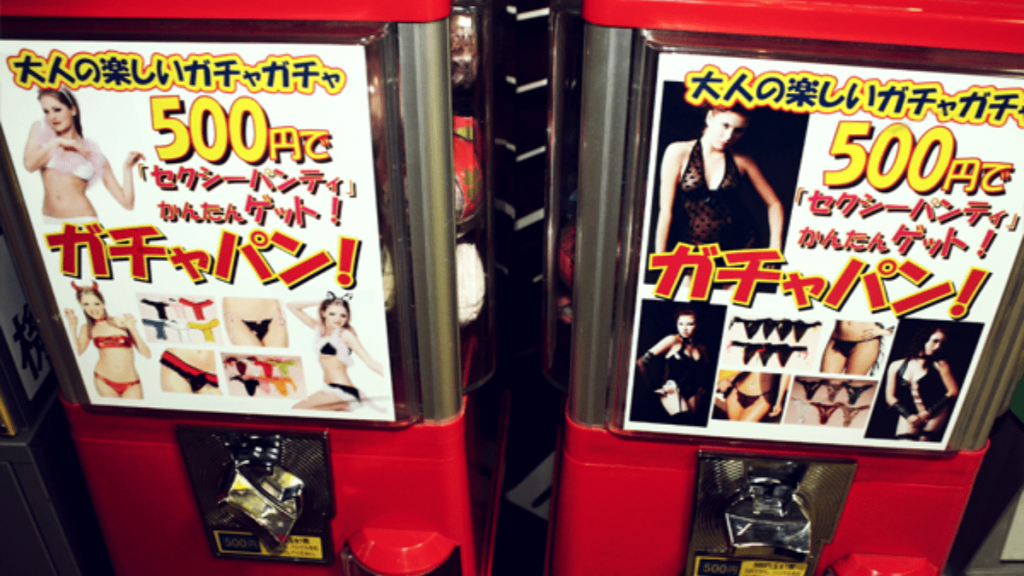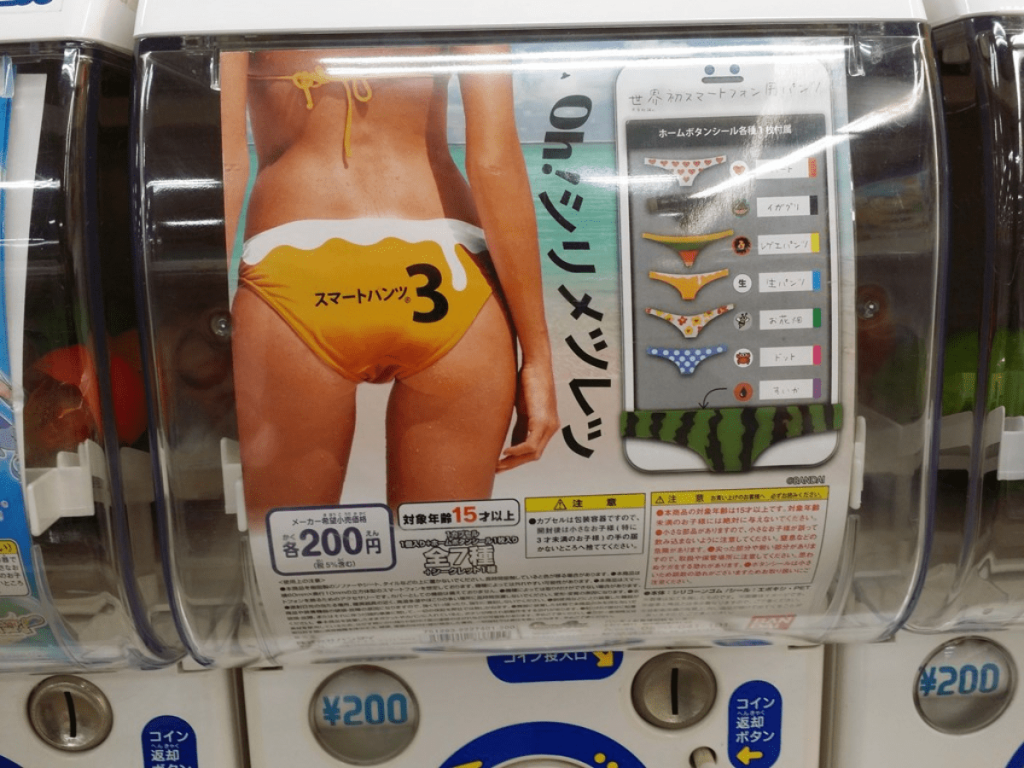When discussing wacky Japanese antics, people often mention used panty vending machines to demonstrate just how bizarre it gets. For some, this is one of the first things they ever hear about Japan.
As a result, many a randy tourist has traversed the country in search of these fabled panty dispensers. More often than not, their quest turns out to be quite the scavenger hunt.
Despite the stereotype that Japan is an eccentric, sex-crazed place, you won’t find these vending machines out in public. In fact, you probably won’t even find them in sex shops. And when you think you’ve finally found one, sorry to break it to you, but you’re probably wrong.
Yet, for nearly three decades, the tale of these used panty dispensers has shaped many foreigners’ image of Japan. So where did it come from? Do they, or did they ever even exist?
Let’s debunk this urban legend together.
Those that have never heard of a used panty vending machine need use but little imagination. It’s exactly what it sounds like and is only shocking to people who don’t know anything about Japan.
The country is literally covered with vending machines. With 5.6 million units across the island nation, there’s 1 for every 23 inhabitants. In the densest parts of cities like Tokyo and Osaka, rows of them line the streets and alleys. You’re unlikely to go much more than a block without seeing one.
Just as remarkable as the sheer number of vending machines in Japan is the crazy variety of goods you can find in them. Though most sell hot and cold drinks, others sell items as random as umbrellas, comic books, canned bread, floral arrangements, and neckties. So is it really that surprising that some might also sell used panties?

In terms of sexual practices and preferences, westerners have long perceived the Japanese to be deviant. Some are shocked and disgusted, some look on in fascination, and some have even adopted certain aspects for themselves. This obsession with Japan’s otherness, regardless of stance, is the driving force perpetuating the used panty vending machine myth. People just love talking about it.
It’s no surprise that this modern shade of orientalism is often sex-centered, considering that sex is Japan’s largest unofficial export. It’s the birthplace of some of the most inventive, unusual, and wildly popular porn genres. Think hentai, bukkake, and tentacle porn, among so many others. But it’s also home to hyper-sexualized cosplay, host and hostess bars, and wildly-themed love hotels.
And then there’s buru-sera, the reason used panties gained popularity in Japan in the first place. Buru-sera is the widespread fetishization of Japan’s sailor-style schoolgirl uniforms and underwear. The name comes from the anglicized Japanese words buru, meaning “bloomers” and sera, meaning “sailor.”
It’s a trope that the entire world is familiar with due to suggestive, if not blatantly sexual, representations of schoolgirls in popular culture from Japan. Video games, comic books, and cartoons show long-legged schoolgirls flashing peeks of their panties, apparently driving men wild. Just ask anyone who had a crush on Sailor Moon.
Buru-sera is just one example from a culture that sexualizes childishness in women, and not just on a niche scale. This youthful ideal is so pervasive that many grown women dress and even act like little girls well into adulthood.

In the early 90s, this nationwide kink gave birth to a used panty cottage industry that capitalized on high schoolgirls. Enterprising young women began selling their underwear as an easy way to make money. They would stop at the shop in the morning, put on a new pair of panties, then return to exchange them for cash after school.
At the time, vending machines had just been invented and were rapidly growing in popularity. It was only a matter of time before someone thought to combine them with used panties. After all, vending machines provided anonymity that promised to encourage shy customers.
According to Snopes, the first used panty vending machines appeared in Chiba City in 1993 in an area that was known for its porn dispensers. As you might imagine, their presence caused an uproar. Not just because they were selling panties, but because they were likely coming from underaged girls.
Locals rallied to get them removed but ran into a hurdle when the authorities had no laws specifically condemning this type of transaction. Eventually, they found a temporary solution in the Antique Dealings Law. This was a regulation that required businesses to have a license to sell used and second-hand goods.
A decade later, Tokyo would go on to pass the Regulations Concerning the Sound Upbringing of Tokyo Youth, which specifically criminalized the trade of used underwear from underaged individuals.
Years before that could happen, though, authorities had already effectively overturned the legality of used panty vending machines. Just months after the first machines were installed, the business owners were charged and the machines were removed. This marked the official end of such vending machines in Japan.
So why, 26 years later, do some people say they still exist and even claim to have seen them?
Used panty vending machines might not have been around for long, but they definitely made a lasting impression. Not only did word of the machines kick off the country’s (and to some extent, the world’s) used panty trade, it also inspired copycats.
While you’re unlikely to come across a traditional vending machine that sells used panties, if you search hard enough, you might find a gachapon machine that does.
Gachapon are small, crank-operated machines that dispense plastic balls with goodies inside. You probably remember them selling toys or candy from when you were a child. Usually, when someone claims to have found an elusive used panty vending machine, this is what they’re referring to.
And those people, almost always, are not Japanese. If they were, they would know that the panties being sold aren’t actually soiled. Though the machines may advertise them that way, they usually include the word kakao, which means “prepared” or “manufactured.”
For as little as $5, you can buy a pair of panties that was made to look used. It might even be artificially scented. Different machines offer a variety of imitation used panties, including schoolgirl panties, urine-stained panties, period-stained panties, and more.
It should seem too good to be true that such a coveted, taboo product be so accessible and cheap. Why, then, do people keep falling for it?
Some gachapon machines are more convincing than others, toting pictures of the female wearers to make it seem legit. Others sell for higher, more convincing prices. Still, there’s no way to know if the “used panties” you’re buying are real, but chances are, they’re not.
In the end, people are going to see what they want to see. And for many an ogling tourist, that means believing that used panty vending machines do indeed exist.

Lovers of worn undies need not be dismayed. Just because Japan’s used panty vending machines are by and large a myth doesn’t mean there isn’t still a thriving used panty trade. What else would you expect from the country that’s more or less responsible for inventing the panty fetish?
In many Japanese sex shops, you’ll find plastic bags filled with pre-loved panties hanging on the wall alongside snapshots of their wearers. There are even entire shops dedicated just to used underwear, like the legendary ROPE shop hidden in the backstreets of Tokyo’s Love Hotel Hill.
Then, of course, there’s the internet, responsible for the worldwide popularity of the fetish, as well as its modern industrialization. Japan has its own online used panty market, but sites like ours have globalized the trade.
Forget the fake used panties you’ll find in Japan’s knockoff vending machines – they’re just tourist traps for giddy travelers looking for a wacky anecdote. Browse the Sofia Gray marketplace to get a glimpse of the real deal and maybe even take home a pair for yourself.